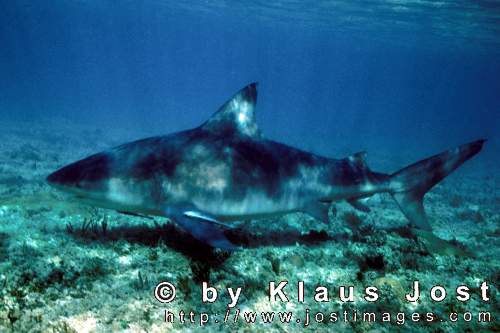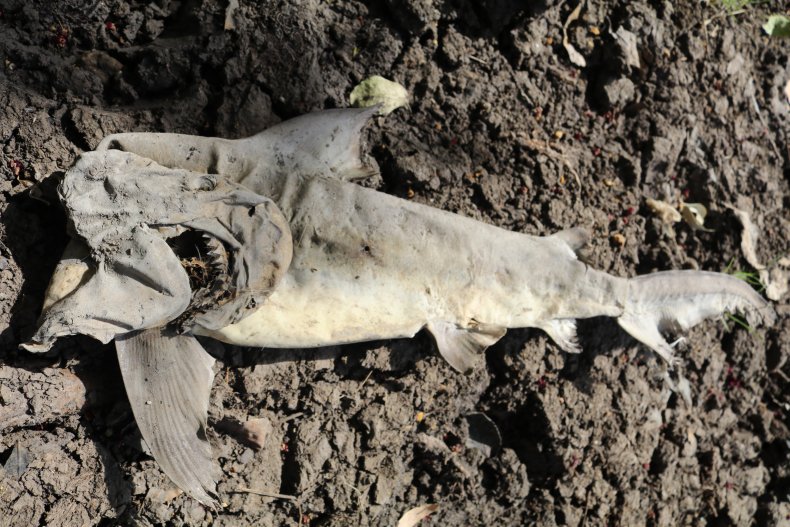Post by Vodmeister on Mar 1, 2014 1:54:43 GMT 5
Carcharhinus leucas

The bull shark, Carcharhinus leucas, also known as the bull whaler, Zambezi River shark or colloquially Zambi, is common worldwide in warm, shallow waters along coasts, and well-known for its unpredictable, often aggressive behaviour. They have a tolerance for fresh water that is unique among marine sharks, and can travel far up rivers, posing a threat to those who venture into the water. As a result they are probably responsible for the majority of attacks on humans that take place near the shore, including many attacks attributed to other species. They may be found far from the ocean but are not true freshwater sharks (unlike the river sharks of the genus Glyphis).
Taxonomy
The name, "bull shark", comes from the shark's stocky shape, broad, flat snout and aggressive unpredictable behavior. In India, the bull shark is often called the Sundarbans or Ganges shark and is considered a delicacy for Bengali fish curries. In Africa it is also commonly called the Zambezi River shark or just Zambi. Its wide range and diverse habitats result in many other local names, for example Nicaragua shark, cub shark, shovelnose shark, freshwater whaler.
Distribution and habitat
The bull shark is common in the coastal areas of warm oceans, in rivers and lakes, and in both salt and fresh water. In the Atlantic it is found from Massachusetts to Southern Brazil and from Morocco to Angola. In the Indian Ocean it is found from South Africa to Kenya, India, Vietnam to Australia. It is estimated that there are more than 500 bull sharks in the Brisbane River and greater numbers still in the canals of the Gold Coast in Queensland, Australia. In the Pacific Ocean, it can be found from Baja California to Ecuador. The shark is found in the central Amazon River, and has been recorded as far up the Mississippi River as Illinois. It is also found in the fresh water Lake Nicaragua and the Ganges and Brahmaputra rivers of West Bengal and Assam in eastern India and adjoining Bangladesh. After Hurricane Katrina hit in 2005, a large number of bull sharks were sighted in Lake Ponchartrain[citation needed]. It is found to a depth of 150 m, but does not usually swim deeper than 30 m.

Anatomy and appearance
Bull sharks are large and stout. The males of this species can reach 2.1 metres (6.9 feet) and weigh 90 kilograms (198.4 lb). The females can be much larger: 3.5 m (11.5 ft) and 230 kg (507 lb). It is wider than other sharks of comparable length. It is grey on top and white below. The second dorsal fin is smaller than the first.
Diet
The bull shark has a varied diet which includes fish, other sharks, rays, dolphins, turtles, birds, molluscs, echinoderms, crustaceans, and even terrestrial mammals.
Behaviour
Bull sharks are mostly sluggish, solitary animals who cruise through shallow waters. They are extremely territorial creatures and once another animal - including humans - enter that territory they can become the target of often fierce aggression. They have the highest level of testosterone of any creature on the planet, even a stampeding elephant. Despite their apparent docility, they are capable of surprising bursts of speed, and can be highly aggressive, even attacking a racehorse in the Brisbane River in the Australian state of Queensland. Along with the great white, tiger and oceanic whitetip sharks, bull sharks are regarded as one of the four species that are considered the most dangerous to humans. There is no consensus, but it is believed that the bull shark is the most likely culprit of the Matawan Creek attacks of 1916.
Reproduction
Breeding takes place in the summer, often in the brackish water of river mouths. After a gestation of about a year, bull sharks give birth to as many as 13 live young (they are viviparous). The young are about 70 cm at birth and take 10 years to reach maturity.
en.wikipedia.org/wiki/Bull_shark#_note-ADW

The bull shark, Carcharhinus leucas, also known as the bull whaler, Zambezi River shark or colloquially Zambi, is common worldwide in warm, shallow waters along coasts, and well-known for its unpredictable, often aggressive behaviour. They have a tolerance for fresh water that is unique among marine sharks, and can travel far up rivers, posing a threat to those who venture into the water. As a result they are probably responsible for the majority of attacks on humans that take place near the shore, including many attacks attributed to other species. They may be found far from the ocean but are not true freshwater sharks (unlike the river sharks of the genus Glyphis).
Taxonomy
The name, "bull shark", comes from the shark's stocky shape, broad, flat snout and aggressive unpredictable behavior. In India, the bull shark is often called the Sundarbans or Ganges shark and is considered a delicacy for Bengali fish curries. In Africa it is also commonly called the Zambezi River shark or just Zambi. Its wide range and diverse habitats result in many other local names, for example Nicaragua shark, cub shark, shovelnose shark, freshwater whaler.
Distribution and habitat
The bull shark is common in the coastal areas of warm oceans, in rivers and lakes, and in both salt and fresh water. In the Atlantic it is found from Massachusetts to Southern Brazil and from Morocco to Angola. In the Indian Ocean it is found from South Africa to Kenya, India, Vietnam to Australia. It is estimated that there are more than 500 bull sharks in the Brisbane River and greater numbers still in the canals of the Gold Coast in Queensland, Australia. In the Pacific Ocean, it can be found from Baja California to Ecuador. The shark is found in the central Amazon River, and has been recorded as far up the Mississippi River as Illinois. It is also found in the fresh water Lake Nicaragua and the Ganges and Brahmaputra rivers of West Bengal and Assam in eastern India and adjoining Bangladesh. After Hurricane Katrina hit in 2005, a large number of bull sharks were sighted in Lake Ponchartrain[citation needed]. It is found to a depth of 150 m, but does not usually swim deeper than 30 m.

Anatomy and appearance
Bull sharks are large and stout. The males of this species can reach 2.1 metres (6.9 feet) and weigh 90 kilograms (198.4 lb). The females can be much larger: 3.5 m (11.5 ft) and 230 kg (507 lb). It is wider than other sharks of comparable length. It is grey on top and white below. The second dorsal fin is smaller than the first.
Diet
The bull shark has a varied diet which includes fish, other sharks, rays, dolphins, turtles, birds, molluscs, echinoderms, crustaceans, and even terrestrial mammals.
Behaviour
Bull sharks are mostly sluggish, solitary animals who cruise through shallow waters. They are extremely territorial creatures and once another animal - including humans - enter that territory they can become the target of often fierce aggression. They have the highest level of testosterone of any creature on the planet, even a stampeding elephant. Despite their apparent docility, they are capable of surprising bursts of speed, and can be highly aggressive, even attacking a racehorse in the Brisbane River in the Australian state of Queensland. Along with the great white, tiger and oceanic whitetip sharks, bull sharks are regarded as one of the four species that are considered the most dangerous to humans. There is no consensus, but it is believed that the bull shark is the most likely culprit of the Matawan Creek attacks of 1916.
Reproduction
Breeding takes place in the summer, often in the brackish water of river mouths. After a gestation of about a year, bull sharks give birth to as many as 13 live young (they are viviparous). The young are about 70 cm at birth and take 10 years to reach maturity.
en.wikipedia.org/wiki/Bull_shark#_note-ADW













